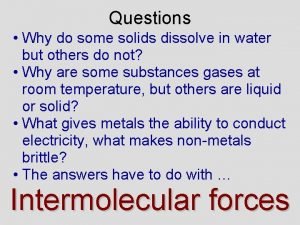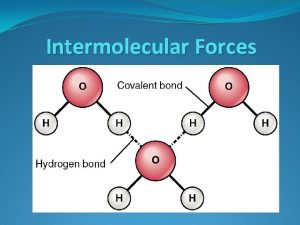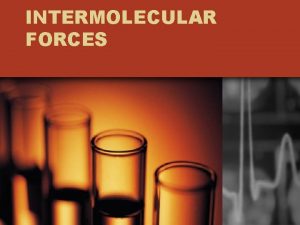Intermolecular Forces Intermolecular Forces Forces that are present









- Slides: 9

Intermolecular Forces

Intermolecular Forces ● Forces that are present between multiple molecules (much weaker than bonds) ● There are 3 types on forces ● Hydrogen Bonding ● Dipole-Dipole ● London Dispersion

Hydrogen Bonding ● 1: Hydrogen Bonding – attractive force between a hydrogen attached to an electronegative atom of one molecule and an electronegative atom of a different molecule (usually N, O or F) ● The attraction between hydrogen and a high electronegative atom ● Strongest intermolecular force ● Involves polar molecules ● Water is a perfect example

Hydrogen Bonding ● Notice that in each case of hydrogen bonding ● The hydrogen is attached directly to one of the most electronegative elements, causing the hydrogen to acquire a significant amount of positive charge. ● Each of the elements to which the hydrogen is attached is not only significantly negative, but also has at least one "active" lone pair.

Dipole-Dipole ● 2: Dipole-Dipole – A polar molecule is attracted to another nearby polar molecule ● 2 nd strongest IM force ● H-bonding is an example

Dipole-Dipole ● Dipole-Dipole must be between POLAR molecules ONLY ● What determines if a molecule is polar? ● Hint: There are 2 things ● Think bond type ● Think Electronegativity

London Dispersion ● 3: London Dispersion – Nonpolar molecules temporarily attract one another ● Weakest IM force ● Electron configuration that temporarily makes the molecule polar

London Dispersion ● London Dispersion must be between NONPOLAR molecules ONLY ● What determines if a molecule is nonpolar? ● Hint: There are 2 things ● Think bond type ● Think Electronegativity

Intermolecular Forces ● Practice: ● a) CH 4 ● London Dispersion ● b) NH 3 ● Hydrogen Bonding ● c) HCl ● Dipole-dipole ● d) Br 2 ● London Dispersion
















